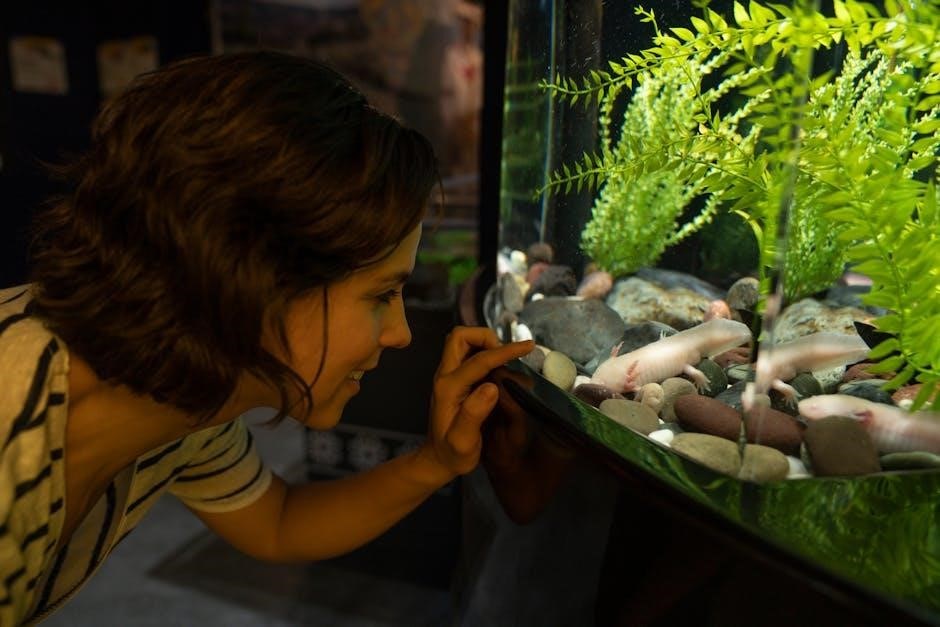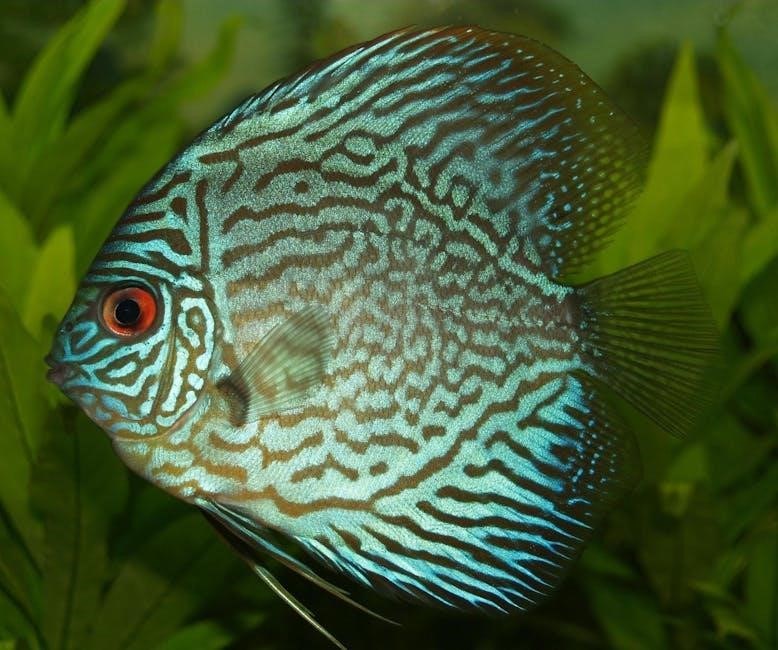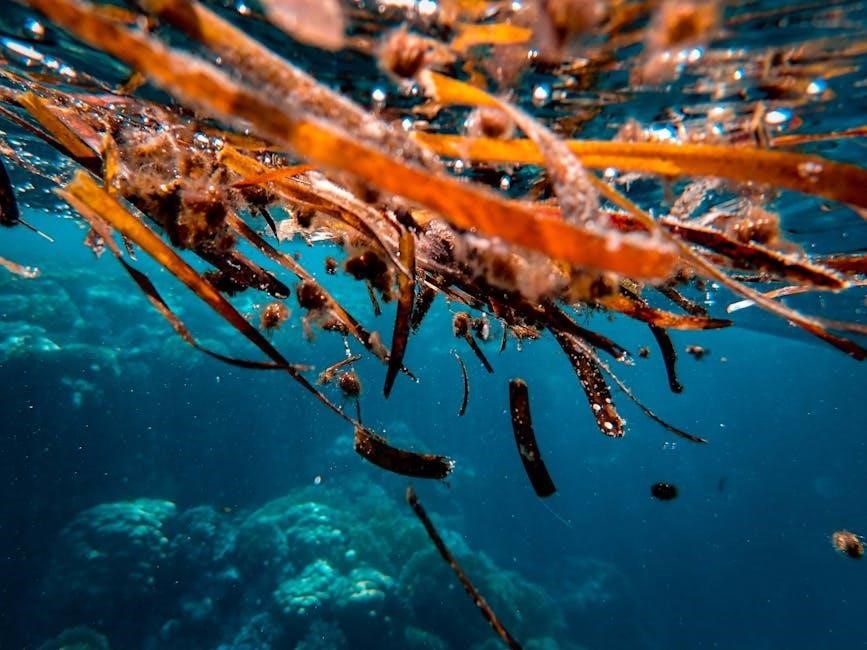aquarium plant guide
Aquatic plants are essential for creating thriving underwater ecosystems. They come in diverse shapes, sizes, and colors, offering aesthetic beauty and supporting aquatic life by improving water quality and providing shelter for fish.
Benefits of Aquarium Plants
Aquarium plants offer numerous benefits for both the ecosystem and enthusiasts. They enhance water quality by absorbing excess nutrients like nitrates and phosphates, reducing algae growth. Plants also produce oxygen, which benefits fish and other aquatic organisms. Additionally, they provide natural shelter and spawning areas for fish, creating a stress-free environment. Aquarium plants help maintain stable water parameters and contribute to a balanced ecosystem. Their natural beauty adds visual appeal, making aquariums more engaging and aesthetically pleasing. By mimicking natural habitats, plants foster biodiversity and promote healthy fish behavior. Regular pruning and proper care can even encourage lush growth, further beautifying the tank. Overall, aquarium plants are a vital component of a thriving aquatic environment, offering both functional and aesthetic advantages.
Choosing the Right Aquarium Plants
Selecting the right aquarium plants involves considering tank size, lighting, and water conditions. Choose species that match your setup, ensuring compatibility with fish and maintenance needs. Start with hardy, low-light plants like crypts or anubias for beginners. Research growth rates and space requirements to avoid overcrowding. Thriving plants enhance aesthetics and water quality, creating a balanced ecosystem.
Popular Freshwater Species
Some of the most popular freshwater aquarium plants include Java Moss, Anubias, and Amazon Swords. Java Moss is a low-maintenance, versatile plant that thrives in various lighting conditions and can carpet the tank floor. Anubias is known for its durable, attractive leaves and prefers low to moderate light, making it ideal for shaded areas. Amazon Swords, with their striking leaf shapes, are popular for mid-ground or background planting and require moderate lighting. These species are favored by aquarists due to their adaptability, aesthetic appeal, and ability to improve water quality. They also provide shelter and spawning sites for fish, enhancing the ecosystem of the aquarium. These plants are widely available and suitable for both beginners and experienced hobbyists.
How to Select Plants for Your Tank
Selecting the right plants for your aquarium involves considering tank size, lighting conditions, and maintenance preferences. Start by assessing your tank’s dimensions to choose plants that fit proportionally. For small tanks, opt for compact species like Java Moss or Cryptocorynes, while larger tanks can accommodate taller plants like Vallisneria or Amazon Swords. Lighting requirements vary; low-light plants such as Anubias are ideal for tanks with limited illumination, while plants like Ludwigia thrive under bright lights. Consider your maintenance routine—low-maintenance plants like Wisteria are great for busy aquarists, while stem plants require regular trimming for optimal growth. Additionally, think about compatibility with your fish; avoid delicate plants if you have active swimmers or herbivorous fish. By matching plant needs to your tank’s conditions, you ensure a thriving and balanced ecosystem. Proper selection enhances both aesthetics and functionality, creating a harmonious underwater environment. Always research specific care requirements to make informed decisions. This ensures your plants flourish and contribute positively to your aquarium’s health. With careful planning, you can enjoy a vibrant, dynamic aquatic landscape. By prioritizing compatibility and care needs, you set your plants—and your tank—up for long-term success. This thoughtful approach not only beautifies your aquarium but also supports the well-being of your aquatic life. Researching and understanding plant profiles will help you make the best choices for your unique setup. Your selections should align with your skill level and available resources, ensuring a rewarding experience. Whether you’re aiming for a lush carpet or a dramatic backdrop, the right plants will elevate your aquarium’s appeal.

Lighting Requirements for Aquarium Plants
Proper lighting is crucial for aquarium plants, as it fuels photosynthesis. Most plants require 10-12 hours of light daily, with low-light species needing less intensity and high-light plants thriving under strong illumination. Avoid overlighting to prevent algae growth. LED lights are ideal for precise control, promoting healthy plant development without harming aquatic life. Lighting intensity and duration must align with plant species to ensure optimal growth and prevent stress. Always research specific lighting needs for your plants to create a balanced and thriving ecosystem. Correct lighting enhances both plant health and aquarium aesthetics, making it a vital component of aquarium setup and maintenance. Ensure your lighting system matches the unique requirements of your aquatic flora for the best results. This attention to detail will contribute to a vibrant and sustainable underwater environment. By tailoring lighting to plant needs, you foster a healthy and visually appealing aquarium. Lighting is a cornerstone of successful aquatic plant care, directly impacting growth rates and overall tank vitality. Choose lighting that complements your plants’ natural habits and your tank’s specific conditions. This ensures your aquarium remains a haven for both plants and fish alike. Lighting adjustments may be necessary as plants grow or new species are introduced, so stay observant and adaptable. The right lighting setup will reward you with lush, thriving plants that enhance your aquarium’s beauty and functionality. Lighting is not just about illumination; it’s about creating an environment where your plants can flourish naturally. With the correct approach, your aquarium will become a stunning display of aquatic life and plant diversity. Remember, lighting is a dynamic element that may need fine-tuning over time to maintain optimal plant health and aquarium balance. By understanding and meeting your plants’ lighting needs, you ensure a harmonious and thriving aquatic ecosystem. Lighting plays a pivotal role in aquarium plant care, so it’s essential to get it right from the start. Always prioritize plant-specific lighting requirements to achieve the best outcomes for your aquatic garden. This careful consideration will lead to a more enjoyable and rewarding aquarium-keeping experience. Lighting is a key factor in the success of your aquarium plant guide, so it’s worth investing time and effort into selecting and adjusting the right system for your needs.
Types of Lighting
There are several types of lighting suitable for aquarium plants, each with unique benefits. LED lights are the most popular choice due to their energy efficiency, adjustability, and long lifespan. They emit minimal heat, reducing the risk of overheating, and can be programmed to simulate natural daylight cycles. T5 and T8 fluorescent lights are traditional options, offering reliable performance and good light penetration for plant growth. However, they produce more heat and require frequent replacement. Halide lights are powerful but generate significant heat, making them less common. Natural sunlight can also be used, but it requires careful control to avoid excessive algae growth. The choice of lighting depends on the specific needs of your plants, tank size, and desired aesthetic. By selecting the right type, you can promote healthy plant growth and maintain a balanced ecosystem.
How to Choose the Right Lighting
Selecting the right lighting for your aquarium plants involves considering several factors. First, determine the type of plants you have, as some require high light intensity while others thrive in low-light conditions. LED lights are ideal for most setups due to their adjustability and energy efficiency. For beginner-friendly plants like Anubias or Java Moss, basic T5 or T8 fluorescent lights suffice. Measure your tank size to ensure even light distribution, and consider the color spectrum—cool tones promote leaf growth, while warmer tones enhance color. Avoid overheating by using timers or dimmers. Budget is also a factor; high-end LEDs offer more features, but simpler options can be cost-effective. Ultimately, balance plant needs, tank size, and personal preference to create an optimal lighting system for your aquarium plants.

Substrate: The Foundation for Healthy Plant Growth
The substrate is a critical component of a planted aquarium, serving as the base for plant roots to anchor and absorb nutrients. A nutrient-rich substrate, such as active soil or specialized aquarium substrates, promotes healthy root development and plant growth. Avoid using regular potting soil, as it can release harmful chemicals and cause water quality issues. Instead, opt for substrates designed for aquariums, like ADA Aqua Soil or Seachem Fluorite, which are formulated to support aquatic plant growth. A layer of gravel or sand can be added on top for aesthetic purposes, but ensure it’s rinsed thoroughly to prevent clouding the water. Regularly maintaining and replacing the substrate as needed will help sustain optimal conditions for your plants to thrive.

Maintenance and Care Tips
Regular pruning and grooming are essential to prevent overcrowding and promote healthy growth. Monitor water quality, maintain proper lighting, and ensure adequate nutrients for optimal plant health and longevity.
Water Quality Management
Maintaining optimal water quality is crucial for the health and growth of aquarium plants. Regular water tests should be conducted to monitor key parameters such as CO2 levels, pH, ammonia, nitrite, and nitrate. Sudden changes in water chemistry can stress plants, so gradual adjustments are recommended. Weekly water changes of 10-20% help remove waste products and replenish essential nutrients. Additionally, ensuring adequate water circulation and oxygen levels supports healthy root development and overall plant vitality. A balanced biological system, achieved through a mature filter, also plays a vital role in maintaining stable water conditions. By consistently monitoring and managing water quality, you can create an environment that promotes thriving aquatic plants and a vibrant ecosystem.
Regular Pruning and Grooming
Regular pruning and grooming are essential for maintaining the health and aesthetic appeal of aquarium plants. Pruning helps control plant growth, prevents overcrowding, and removes dead or decaying leaves that can harm water quality. Use sharp, clean tools like scissors or pruning clippers to avoid damaging the plants. For stem plants, trim back overgrown stems to encourage bushy growth. For carpeting plants, gently rake or trim excess growth to maintain an even appearance. Regular grooming also involves rearranging plants to create a balanced layout. Prune weak or leggy growth to redirect energy to healthier parts of the plant. By incorporating pruning into your routine, you can promote vibrant, balanced plant growth and enhance the overall beauty of your aquarium.
Common Mistakes to Avoid
When cultivating aquarium plants, several common mistakes can hinder growth and water quality. Overcrowding is a frequent issue, as it limits light and nutrient availability. Using incorrect substrate or neglecting to provide adequate lighting for specific plant species can also lead to poor growth. Inconsistent water changes and improper fertilization are additional pitfalls, as they disrupt water parameters and stress aquatic life. Overstocking with fish can increase waste, harming plant health. Avoid introducing invasive species, as they can outcompete native plants. Regular monitoring and adjustments are crucial to maintaining a balanced ecosystem. By addressing these mistakes, aquarists can create a thriving environment for their plants and fish.

Propagation of Aquarium Plants
Propagating aquarium plants is a rewarding process that allows you to share plants with others or expand your collection. Many species can be propagated through division, where mature plants are carefully separated into smaller sections and replanted. Trimming stem plants and replanting the cuttings is another effective method. Some plants, like mosses and liverworts, can be divided and attached to rocks or driftwood. Regular pruning encourages bushy growth and promotes healthy rooting. For certain species, like carpeting plants, splitting and replanting mats works well. Proper lighting, nutrients, and stable water conditions are essential for successful propagation. With patience and the right techniques, you can easily multiply your favorite aquarium plants and create a lush, vibrant ecosystem;
Troubleshooting Common Issues
Common issues with aquarium plants often stem from poor water quality, inadequate lighting, or improper care. Yellowing or droopy leaves may indicate nutrient deficiencies or excessive light exposure. Slow growth could result from insufficient nutrients or poor water circulation. Algae overgrowth, especially on leaves, suggests imbalanced lighting or excess nutrients. Regular water changes, maintaining stable parameters, and ensuring proper lighting can resolve many problems. Pruning affected areas and adjusting care routines helps restore plant health. Identifying root causes, such as over-fertilization or lack of CO2, is key to preventing recurring issues. By addressing these factors promptly, aquarium plants can thrive, creating a balanced and visually appealing underwater environment.
Enhancing Aquarium Aesthetics with Plants
Aquarium plants are a powerful tool for enhancing the visual appeal of your tank. By selecting plants with varying shapes, colors, and growth patterns, you can create a dynamic and natural underwater landscape. For example, carpeting plants like Java Moss or Dwarf Sagittaria can form a lush, green foreground, while taller species such as Amazon Swords or Vallisneria can add dramatic height to the background. Mixing textures and colors adds depth and visual interest, making the aquarium a centerpiece of any room.
Strategically placing plants can also create hiding places for fish, mimicking their natural habitats. This not only beautifies the tank but also promotes a sense of calm and balance. With careful planning, aquarium plants can transform your tank into a stunning, thriving ecosystem that captivates all who see it.
Compatibility with Aquarium Fish and Other Plants
Ensuring compatibility between aquarium plants and fish, as well as among plants themselves, is crucial for a harmonious tank. Some plants, like Anacharis, can coexist peacefully with most fish, while others, such as invasive species, may outcompete or harm tankmates. Certain fish, like herbivorous species, may eat or damage plants, so selecting plant species that are resilient or unappealing to these fish is essential. Additionally, plants with aggressive growth habits, such as Vallisneria, can overshadow slower-growing plants, leading to competition for resources. By choosing compatible plants and fish, you create a balanced ecosystem where all inhabitants thrive. Researching the specific needs and behaviors of both plants and fish helps achieve this synergy, ensuring a stable and visually appealing aquarium environment.
Where to Buy Aquarium Plants and Supplies
Acquiring high-quality aquarium plants and supplies is essential for creating a thriving aquatic environment. Reputable online retailers like Aquarium Co-Op (https://aquariumcoop.com/) offer a wide variety of plants, lighting, and fish food. Local pet stores specializing in aquatic life are also excellent sources, providing personalized advice and fresh stock. Additionally, online marketplaces and forums often feature independent sellers offering rare or unique plant species. When purchasing, ensure the plants are healthy, free of pests, and suitable for your tank conditions. Always research the seller’s reputation and read reviews to guarantee a positive experience. Whether shopping online or in-store, choosing the right supplier ensures your aquarium plants and supplies meet your needs for a beautiful and functional setup.
